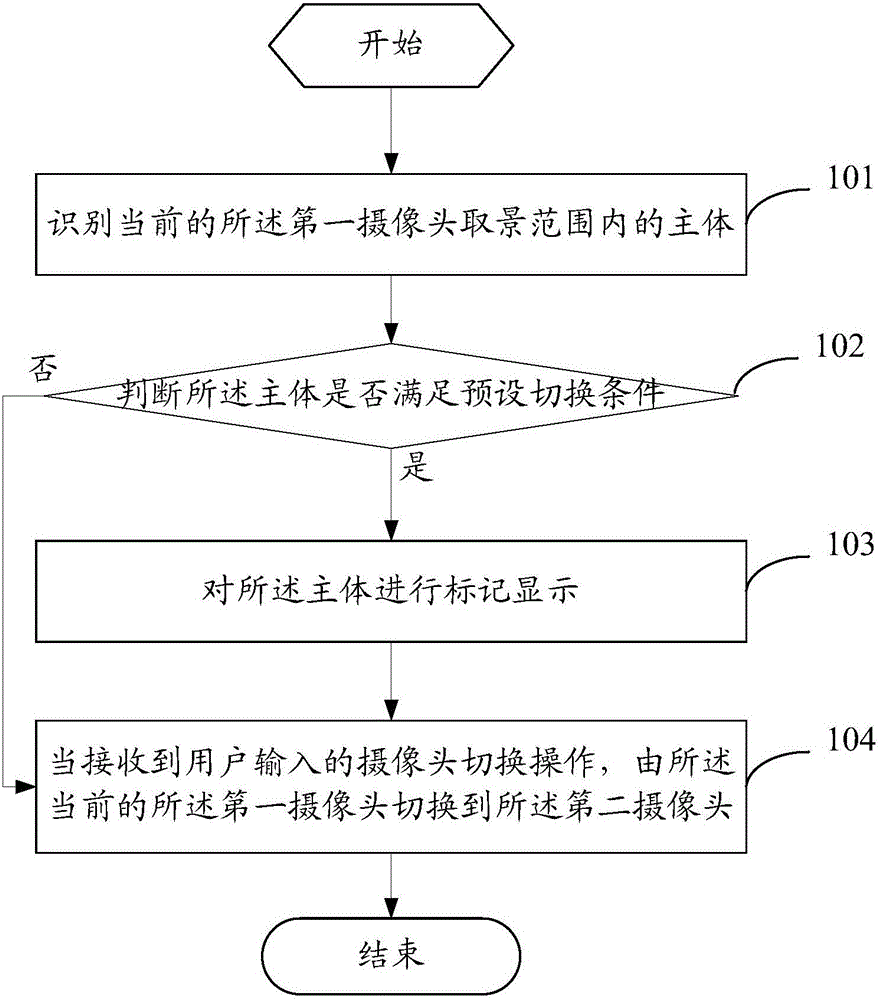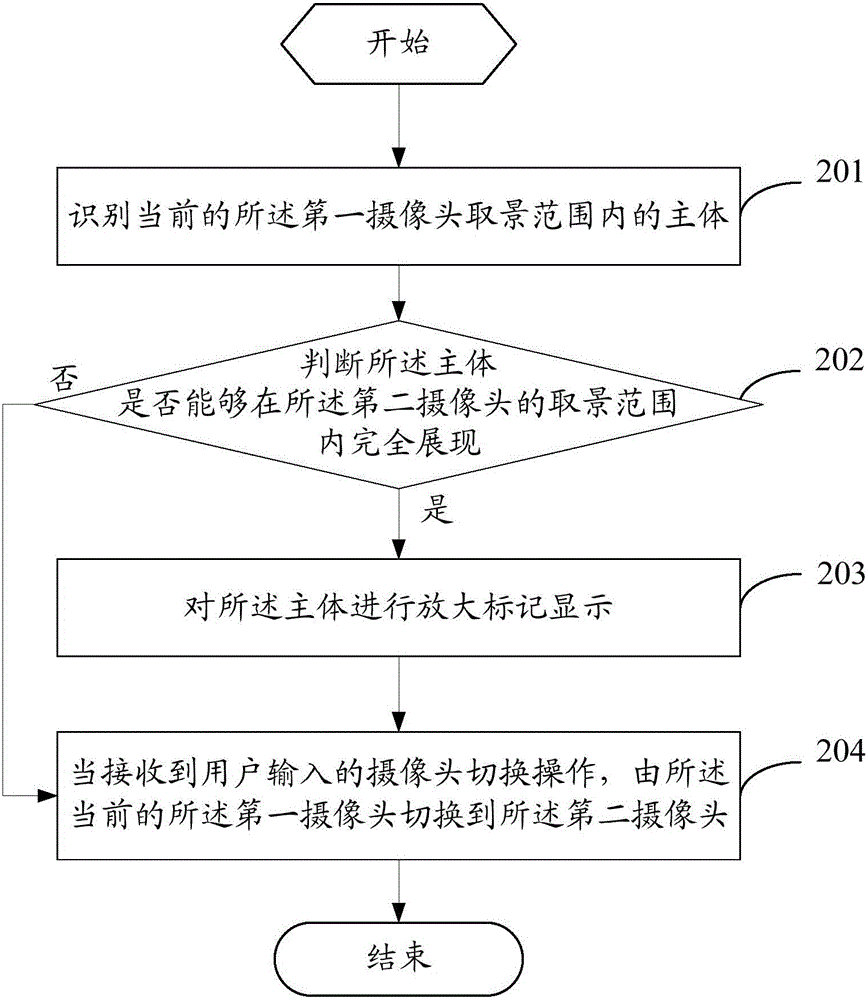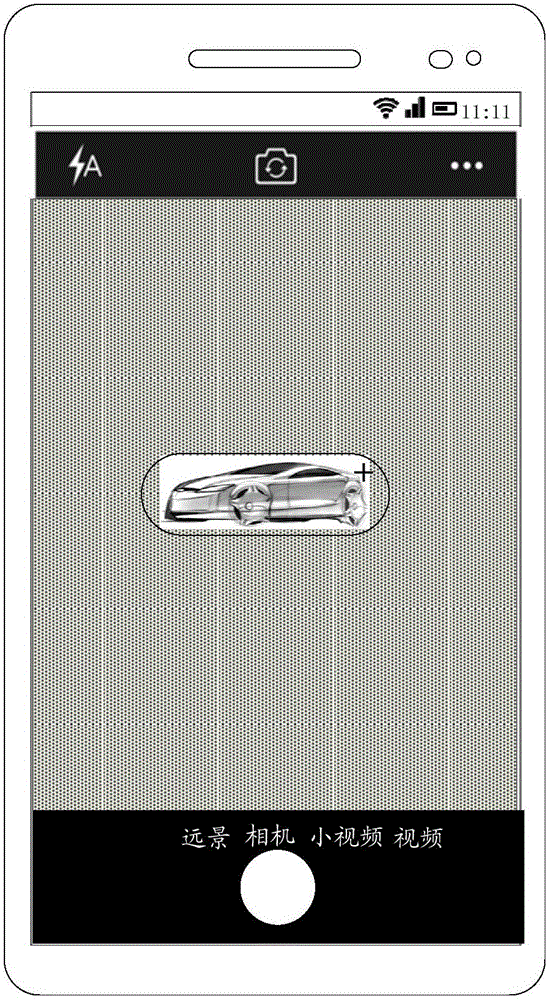Camera switching method and mobile terminal
A mobile terminal and camera technology, applied in the field of communications, can solve the problem of not meeting the needs of users for shooting
- Summary
- Abstract
- Description
- Claims
- Application Information
AI Technical Summary
Problems solved by technology
Method used
Image
Examples
no. 1 example
[0030] see figure 1 , figure 1 It is a flowchart of a camera switching method provided by an embodiment of the present invention, the method is applied to a mobile terminal, the mobile terminal includes at least a first camera and a second camera, and the first camera and the second camera work independently ,Such as figure 1 shown, including the following steps:
[0031] Step 101. Identify subjects within the current viewing range of the first camera.
[0032] In the embodiment of the present invention, the fact that the mobile terminal includes at least the first camera and the second camera may be understood as that the mobile terminal may include other cameras besides the first camera and the second camera. For example, the above-mentioned first camera and the second camera are rear cameras, and the mobile terminal may further include a front camera and the like. Of course, in some scenarios, one or both of the first camera and the second camera may be front cameras. ...
no. 2 example
[0046] see figure 2 , figure 2It is a flowchart of another camera switching method provided by an embodiment of the present invention, which is applied to a mobile terminal. The mobile terminal includes at least a first camera and a second camera, and the first camera and the second camera work independently. And the first camera is a wide-angle camera, and the second camera is a telephoto camera or a standard camera, such as figure 2 shown, including the following steps:
[0047] Step 201. Identify subjects within the current viewing range of the first camera.
[0048] Step 202. Determine whether the subject can be fully displayed within the viewing range of the second camera, and if so, determine that the subject satisfies the preset switching condition.
[0049] In the embodiment of the present invention, judging whether the subject can be fully displayed within the viewing range of the second camera can be understood as a process of estimation, that is, the judgment ...
no. 3 example
[0082] see Figure 4 , Figure 4 It is a flow chart of another camera switching method provided by an embodiment of the present invention. The mobile terminal includes at least a first camera and a second camera, and both the first camera and the second camera work independently, such as Figure 4 shown, including the following steps:
[0083] Step 401 , identifying subjects within the current viewing range of the first camera.
[0084] Step 402. Determine whether the current first camera is a telephoto camera, and if so, determine that the subject meets the preset switching condition.
[0085] In this embodiment, through step 402, when the first camera is a telephoto camera and the second camera is a wide-angle camera or a standard camera, it can be determined that the subject meets the preset switching condition. Because the viewing range of the telephoto camera is small, the main body of the first camera must be fully displayed in the viewing range of the second camera. ...
PUM
 Login to View More
Login to View More Abstract
Description
Claims
Application Information
 Login to View More
Login to View More - R&D
- Intellectual Property
- Life Sciences
- Materials
- Tech Scout
- Unparalleled Data Quality
- Higher Quality Content
- 60% Fewer Hallucinations
Browse by: Latest US Patents, China's latest patents, Technical Efficacy Thesaurus, Application Domain, Technology Topic, Popular Technical Reports.
© 2025 PatSnap. All rights reserved.Legal|Privacy policy|Modern Slavery Act Transparency Statement|Sitemap|About US| Contact US: help@patsnap.com



